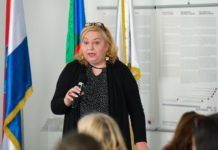The representation of Roma through historical and artistic narratives is flooded with stereotypes and clichéd depictions that range from fantasy and mysticism to mistrust and contempt. But how do Roma want others to see them and how do they see themselves? In order to create a reliable source of knowledge that would be digitally accessible and created by the Roma community itself, it led to the launch of the Roma digital archive. I spoke with Isabel Raabe, a curator who is in search of decolonial practices and new narratives in her work, believing in artistic forms of knowledge production. Raabe, together with Franziska Sauerbrey, after extensive research into the artistic and cultural (self-)representation of Roma and numerous interviews with Roma artists, curators, activists and academics across Europe, launched RomArchive, which, as they state on the project’s official website, makes visible art and Roma culture, illustrating their contribution to European cultural history. Guided by the idea that the Roma in key positions will be the ones who will define and design the archive, they gathered a global network of cultural actors, scientists and activists, which will result in the centuries-old archival material becoming publicly available and visible for the first time.
How did the idea for founding the RomArchive come about? Many international curators, in various ways, are involved in its work. In what way does this shape and enrich the work of RomaArchive and the offer of archive collections?
In 2012, Franziska Sauerbrey and I supported the cultural framework programme for the opening of the memorial for Sinti and Roma murdered under National Socialism in Berlin. We were confronted both with our own gaps in knowledge (for example, we found nothing about the Holocaust against the Sinti and Roma in our school textbooks) and with diverse cultural treasures of the Sinti and Roma. The urgency to take action here was evident. So we contacted the Federal Cultural Foundation, initially with the very openly formulated request: as the largest cultural foundation in Europe, wouldn’t you like to deal with the largest minority in Europe with 12 million people? The interest was great and Franziska Sauerbrey and I were entrusted with international research that was to clarify: What does the community need? What kind of project would make sense? In the course of our research, we spoke with artists, politicians and activists in all European countries. One answer we heard again and again was: we need more visibility. We need a museum that presents our cultures. Now, of course, the construction of Roma museums in all European metropolises is not the task of the Federal Cultural Foundation. The idea of a digital archive was born, which as a format could meet the transnational community of Sinti and Roma. The Federal Cultural Foundation funded the project for its implementation up to the launch, partner for the technical implementation was found in the Stiftung Deutsche Kinemathek, and the Federal Agency for Civic Education provided follow-up funding for the long-term host of the digital archive, the Documentation Centre of German Sinti and Roma, in Heidelberg.
More than 150 people from 15 countries were involved in the development of the RomArchive. Each section of the archive had its own curator. This enabled one thing above all: to show the diversity of Roma cultures. Through the large network of curators and their working groups, RomArchive had access to a great many private and institutional archives all over Europe.
How would you describe RomArchive and its focuses? Out of which necessity arose the need to build and manage the Archive?
The RomArchive has the following central goals: Creating visibility, overcoming stereotypes, reconstructing history and decolonising knowledge. It is not only aimed at majority societies, but also at the minority itself. The art historian Timea Junghaus, who curated the visual arts section of the archive, once said “It is a basic human right to have access to one’s own culture”.
RomArchive follows the guideline “Nothing about us without us”. The contents of the ten archive sections (visual arts, literature, music, theatre, flamenco, dance, film and the contextualising sections on image politics, the civil rights movement and Voices of the Victims on the Holocaust against the Sinti and Roma) have been compiled by curators from the communities. This is new.
There was also no central place before that collected the cultural wealth of the Sinti and Roma to this extent and made it accessible. We were able to establish valuable cooperations with archives such as the Phonogrammarchiv Wien, which has unique oral history recordings, or the Hungarian Academy of Science and the Centro Andaluz de Flamenco, which provided us with historical image and sound material on Hungarian dances and the flamenco gitano. Over 5000 records can be found in the database. A diverse picture of the cultures of the Sinti and Roma is emerging. I deliberately use the plural, because THE Roma or Sinti culture does not exist.
As a pioneering project, RomArchive has won numerous prizes. In addition to the Grimme Online Award 2020, it was awarded the European Heritage Award in 2019.
In addition to the materials published on its website, RomArchive has an Internal Archive. Can you describe how you build and maintain it all together (selection of documents, preservation of materials, digitization and/or physical storage of documents, technical and spatial prerequisites, division of work within the organization – who does this work…)?
The internal archive, i.e. the database, contains 5,000 objects. Only a part can be seen online. Access to the internal archive can be requested.
In the start-up phase, the technological level was set up and maintained by the Sitftung Deutsche Kinemathek. Now the Documentation Centre of German Sinti and Roma and the curators or their team have to do this themselves. This means. Digitising, inventorying in the database, cataloguing, indexing. If the objects are to be shown online, there is also editing work: contextualising texts, naming the credits and, of course, clarifying rights. RomArchive works with creative commons rights (cc licences).
Taking into account that through this Archive you are trying to avoid the pitfalls of presenting an unrealistic image of a homogenous ‘Roma culture’, how challenging was it to represent the diversity of various cultures? What would you list as key barriers and problems you face?
The RomArchive was in no way allowed to run the risk of trying to define what Roma culture is, to create a narrow image again. No, RomArchive shows the heterogeneity of Roma and Sinti communities in the world and even contains contradictory information. For example, some say that colourful backs are a stereotype and others say that this is how my grandmother still dresses today. RomArchive has to endure these contradictions.
RomArchive would rather show blurriness than capture an image. This provokes a closer look.
What are experiences and examples of your cooperation (academic community, other CSOs, state or local archives) in archiving?
The overwhelming majority of the objects initially came from private collections. Which also reflects the fact that there are no places where archives existed before. Of course, we also entered into a few institutional collaborations, with the Phonogrammarchiv in Vienna, with the Hungarian Academy of Science in Budapest or with the Centro Andaluz de Flamenco, but these were rather the exceptions. In the area of the civil rights movement, of course, a lot came from the Documentation and Cultural Centre of German Sinti and Roma in Heidelberg as the contact point for visual material.
In addition to opportunities for learning, research, and interaction, archives help build a community with a strong sense of identity. How is the community involved in archiving within RomArchive?
The communities themselves use the archive for their own work. I am referring to activists who see the knowledge compiled in the RomArchive as a tool. They try to draw on concrete sources for their activist work in fields as diverse as Holocaust research or civil rights work.
Since most of the material comes from private archives, the community has been involved in the development of the RomArchive from the beginning.
Which sources of financing do you use/are available for your work and are they adequate? What challenges do you think the future holds for the field of archives?
The Federal Cultural Foundation funded the project with 3.75 million euros for the implementation until the launch, the Goethe Institute also supported the project and the Federal Agency for Civic Education provided follow-up funding. That sounds like a lot of money (and it is), but considering the long development period (6 years) and the many people involved in the project (150 people), it was a reasonable sum.
The interview was originally published on the Kulturpunkt portal and is part of the research of an informal initiative of independent archives and libraries for a better position of non-institutional archives.












